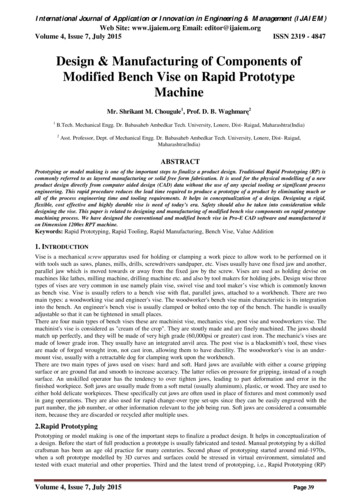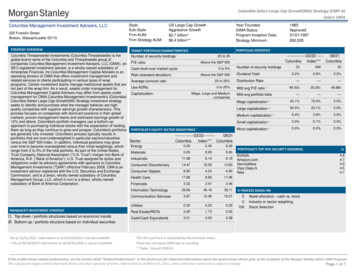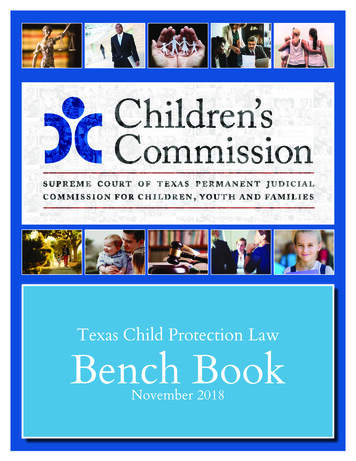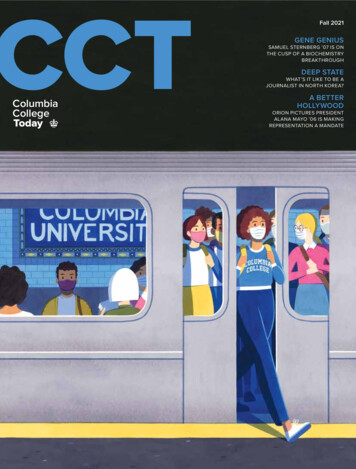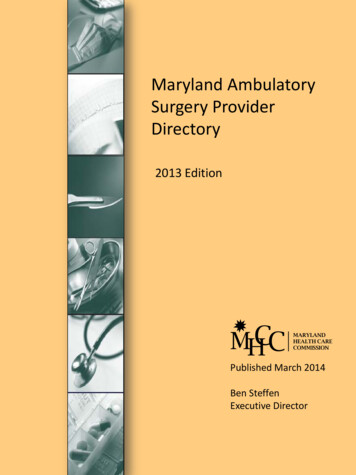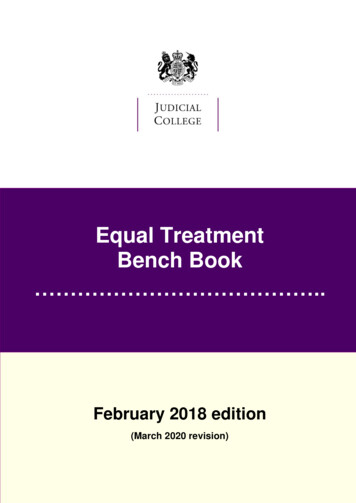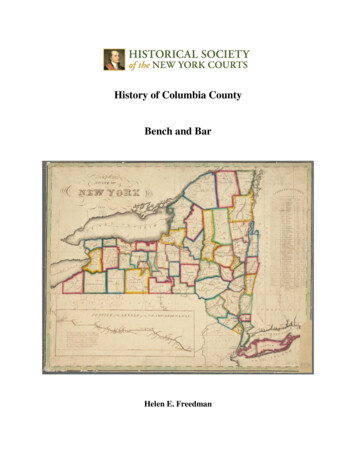
Transcription
History of Columbia CountyBench and BarHelen E. Freedman
ContentsI.County Origins2a. General Narrative2b. Legal and Social Beginnings3c. Timeline4II.County Courts and Courthouses6III.The Bench and The Bar10a. Judges and Justices10b. Attorneys and District Attorneys19c. Columbia County Bar Association24IV.Notable Cases25V.County Resources and References28a.Bibliography28b. County Legal Records and their Location28c. County History Contacts29i.Town and Village Historians30ii.Local Historical Societies31iii.County, Town & Village Clerks32108/13/2019
I.County Originsa. General NarrativeIn September of 1609, Henry Hudson, an Englishman sailing under the auspices of theDutch East India Company, set foot in what was to become Columbia County. When he steppedoff his vessel, the Half Moon, he was the first European to arrive and was greeted by nativesfrom the Mohican tribes who had settled in what is Stockport today.1Starting in about 1620, Dutch immigrants settled the area along the Hudson River andextending east to the Massachusetts border, pursuant to land patents issued by the Dutch WestIndia Company. Large manorial tracts were granted to the Van Rensselaer family, mostly in thenorthern part of the county and further north, starting in 1629. Kiliaen Van Rensselaer, a diamond and pearl merchant from Amsterdam and a director of the Dutch West India Company,founded the Manor of Rensselaerswyck in 1630, which included what is now the Capital Districtand Rensselaer and part of Columbia Counties. The Dutch often just settled rather than purchasing the land from the Natives.2After the British naval forces captured the Hudson River Valley territory in 1664, representatives of the Crown engaged in transactions with the Natives by purchasing land and thenissuing land patents. Although the Dutch recaptured the area in 1673, the English regained itunder the Treaty of Westminster in 1674. Dutch was spoken in Columbia County well into themiddle of the 19th century.3The first land patents issued by the English Crown were those granted to the Livingstonfamily and were recorded in or about 1684. The Livingstons became the controlling manorialfamily in the southern part of Columbia County. Robert Livingston, the largest patroon, actually1History of Columbia County New York, by Everts & Ensign, J.B. Lippincott & Co., Philadelphia 1878, p.3.John C. Brooke, Columbia Rising, University of North Carolina Press, 2010, p. 40.3Interview with Carl Whitbeck, Esq. whose family dates back to the 1600’s. Dutch was Martin Van Buren’s firstlanguage.2208/13/2019
returned some of the land to Queen Anne in 1710. In or about1740, Robert Livingston brought 1200 German or Palatine farmers over to work on the part of his estate now known as Germantown. The original Livingston patent was partly located inDutchess County, but in 1799, thirteen years after its creation asa separate County, Columbia County’s southern border waslowered to encompass the entire Livingston holdings.Robert Livingstonb. Legal and Social BeginningsFort Orange was established along the Hudson River as a trading post with Natives in1629. While Mohican Natives occupied the eastern shore, Mohawk and Iroquois Natives occupied the lands west of the Hudson. That region became Albany County under the English, andencompassed the entire area north of Dutchess County until after the Revolutionary War. In1786, pursuant to a proposal made by Senator Philip Schuyler, the state legislature carved Columbia County out of Albany County. The newly created County with its own legal system wasbounded on the north by Rensselaer and Albany Counties, on the south by Dutchess County,on the east by Berkshire County in Massachusetts and on the west by the Hudson River. Currently, the county consists of 648 square miles of which 634 are land and 14 are waterways.While the County was heavily populated with tenant farmers who worked on the largemanorial estates and possessed no ownership rights, towns like Claverack, Chatham andKinderhook were home to small Dutch and German merchants and tavern owners like the VanBurens, Van Alens, Staats, and Van Nesses. Their children would become notable political andlegal figures, along with the Livingstons and Van Rensselaers, in the newly established County.308/13/2019
c. Timeline1609Henry Hudson sails past Poughkeepsie and stops in Stockport.1629Dutch patroon system was established.1664British capture what had been New Netherlands.1673Dutch recapture the area briefly but relinquish to British in 1674.1684English Crown grants large patent to Robert Livingston.1772Regions of Columbia County were divided into districts consisting of Kinderhook in thenorthwest, King’s in the northeast, Claverack in the central portion, and LivingstonManor in the south. The Germantown district was formed from part of Livingston Manoron April 1,1775, and the Hillsdale district was taken from Claverack on March 26,1782.1785The City of Hudson was incorporated on April 22, 1785.1786Columbia County created as a separate entity by the State legislature on April 4, 1786.1786Claverack became the County Seat. The first Courthouse was built, and the Court ofCommon Pleas was established.1788Additional towns were created into the 1800’s, increasing the total to 18.1796By L. 1796 Ch.8, the New York State Legislature divided the state into seven districtswith an assistant attorney general to serve in each. Columbia County was in the thirddistrict and was grouped with Albany, Greene, Rensselaer, Schoharie, Sullivan andUlster Counties.1801By L. 1801, Ch. 146 the State Legislature created “district attorneys.”1805The County Seat was moved to Hudson and the County Courthouse was relocated toHudson City Hall.1835The third Courthouse was erected.1836Martin Van Buren of Kinderhook and Hudson was elected United States President.1846Current State Court system established.408/13/2019
1900The fourth Courthouse, designed by architect Henry S. Moul, was erected after the thirdwas razed.1907The fifth Courthouse, designed in Beaux Arts style by Warren & Wetmore, was erectedafter fire destroyed the previous one on January 27, 1907.1985Hon. Roger J. Miner of Hudson New York was appointed to United States Court ofAppeals for the Second Circuit.2014The Warren & Wetmore Courthouse was renovated and expanded and dedicated toHon. Roger J. Miner on November 14, 2014.508/13/2019
II. County Courts and CourthousesCountywide, Regional and Statewide CourtsIn 1786, the Court of Common Pleas of Columbia County was established. There wasalso a Surrogates Court, and Supreme Court Justices sat in Columbia County from time to time.Appeals could be taken from judgments of these courts and judges to the Court for the Correction of Errors in Albany, which had both legal and equitable jurisdiction. Land disputes constituted a significant portion of the civil dockets of these courts in the late 18th and early 19th century, and became the source of the livelihood for many prominent lawyers such as future President Martin Van Buren. The current court structure was established under the State Constitutionof 1846.Local Courts.Justices of the Peace courts were also established for the various towns and villageswithin the County in the late eighteenth century. The Judges of those courts were appointed bythe State legislature until 1834 when the positions became elective. In 1967, all Justices of thePeace in Columbia County were renamed Town or Villages Justices. Currently, only about 30percent of the Town and Village judges are lawyers. Those judges preside over arraignmentsand preliminary hearings and take misdemeanor pleas. They also preside over civil caseswhere the amount in issue is no more than 3,000.In 1896, the Hudson City Court was established. Currently, that court has the samecriminal jurisdiction as the Town and Village courts have, but has civil jurisdiction of up to 15,000 and Small Claims jurisdiction up to 5,000. The Hudson City Court has county-widecivil and criminal jurisdiction (Laws of New York, 1895, Ch. 751).608/13/2019
First County Court HouseIn 1786, the village of Claverack was established as the County Seat and became hometo the first County Court. The Court House wassituated next to the Dutch Reformed Church onland that was acquired from one Gabriel Esselstyne on June 7, 1786. A mural depictingHon. Peter Van Ness (1734-1804), the FirstFirst Columbia County Courthouse in ClaverackJudge of the Court of Common Pleas of theCounty of Columbia, arriving at the Claverack Courthouse in 1787, is displayed in the HudsonCounty Courthouse today. Other judges presiding in Columbia County during the early yearsincluded Peter Sylvester, Peter R. Livingston, Henry I. Van Rensselaer, Stephen Hogeboom,Robert Yates and Isaac Hoes.First Columbia County Courthouse in ClaverackFirst Columbia County Courthouse in ClaverackSecond County Court HouseIn 1805 the County Seat was moved to Hudson, necessitating relocation of the CountyCourt. From 1805 to 1835 the Court resided in what was formerly the Hudson City Hall. TheCity Hall had been built in 1785, the year that the Village of Hudson was incorporated. On June7, 1785, a Mayor’s or Recorder’s Court opened in Hudson. While some cases were tried in thatCourt, it did not function regularly.708/13/2019
Third Columbia County CourthouseThis courthouse, featuring ionic columns and a dome, was erected in 1835 on thesquare at Warren and South Fourth Street and lasted until 1900 when it was razed.Third Columbia County CourthouseFourth Columbia County CourthouseThis courthouse, featuring more columns and a larger dome, lasted only seven years asit was destroyed by a fire in 1907.Fourth Columbia County Courthouse, Hudson808/13/2019
Fifth Columbia County CourthouseThis Courthouse, describedas “a magnificent Beaux Arts building,” was designed in 1908 by theWarren & Wetmore Columbia County Courthousearchitectural firm of Warren &Wetmore, the same firm that designed Grand Central Station in NewColumbia County Courthouse, 1908York County. It is said to “brilliantlyColumbia County Courthouse, 1908make reference to and harmonizewith the surrounding buildings.”4 Thedome is far less dominant. The ioniccolumns are gone and replaced withtwo more subtle Corinthian columns.The square in front of the courthousefeatures benches, an octagonal gazebo and four war memorials toColumbia County soldiers ofColumbia County Courthouse, present dayWorld War II, the Korean and Viet Nam Wars, and the 1991 Desert Storm military action. ThatCourthouse was renovated and expanded over a twenty-year period ending in 2014. In 2014,the Courthouse was dedicated to Hon. Roger J. Miner who served on the United States Court ofAppeals for the Second Circuit from 1985 until his death in 2012.4See pamphlet describing Courthouse published in 2014 by Unified Court System.908/13/2019
II. The Bench and The Bara. Judges and JusticesCOURT OF COMMON PLEAS AND PRE-1846 SUPREME COURTHon. Peter Van Ness (1734-1808) of Claverack, Columbia County, NY was the FirstJudge of the Court of Common Pleas of the County of Columbia. He arrived at the ClaverackCourthouse when the new County was established in 1786. Other Judges who presided duringthe early years included Peter Sylvester (1734-1808), of Kinderhook, also appointed in 1786.Peter R. Livingston (1766-1847) of Rhinebeck, Henry I. Van Rensselaer (1742-1813) ofClaverack, and Stephen Hogeboom (1744-1814) of Claverack.Hon. Robert Yates (1738-1801) of Albany was a Supreme Court Justice beginning in1777 who also served in the Claverack Courthouse. He became Chief Justice of the New YorkSupreme Court in 1790.Hon. Morgan Lewis (1754-1844) of Rhinebeck and Albany, (sat in Columbia County) served in several prominentroles: New York State Attorney General, (1791-92); Justice ofNew York Supreme Court (1792-1801), Governor of New York(1804-1807). Member of the New York State Senate MiddleDistrict (1811-14); and General of the US Army during the Warof 1812.Morgan Lewis1008/13/2019
Hon. James Kent, (1763-1847) of Poughkeepsie,Dutchess County, New York was Justice of the Supreme Courtfrom 1798-1804. On occasion, he sat in Columbia County. Hewas Chief Justice, 1804; Chancellor of New York, 1814; member of the New York State Assembly, 1790-91, 1792-93, 179697 (Dutchess County); and author of Commentaries on American Law, the first comprehensive treatment of the subject.James KentHon. Ambrose Spencer (1765-1848) of Hudson, NewYork was Associate Justice New York Supreme Court, 18041819; Chief Justice New York Supreme Court, 1819-1822; andNew York Attorney General, 1802-1804.Ambrose Spencer1108/13/2019
FEDERAL JUDGE FROM COLUMBIA COUNTYRoger J. Miner (1934-2012)--of Hudson, New York graduatedfrom New York Law School in 1956. He served as UnitedStates District Judge for the Northern District of New York(1981-1985) and Judge of the United States Court of Appealsfor the Second Circuit (1985-2012) He was said to have beenon the “short list” for elevation to the United States SupremeCourt during the administration of President Ronald Reagan.Before his service on the federal courts, Judge MinerRoger J. Minerwas District Attorney of Columbia County from 1968 to 1976 andthen a Justice of the New York State Supreme Court for the Third Judicial District from 1976 to1981. Judge Miner died in 2012, two years before the renovated Columbia County Courthousewas dedicated to him.NEW YORK STATE APPELLATE DIVISION, THIRD DEPARTMENTSamuel Edwards (1832-1912) of Chatham and Hudson, New York was born in Schenectady,New York and served on the Appellate Division for one day in 1896 and again for the year 19001901.Aaron V.S. Cochrane (1858-1943) of Hudson, New York served on the Appellate Division from1906-1911 and again from 1915-1928. From 1922-28, he served as Presiding Justice of theThird Department.Daniel V. McNamee (1874-1939) of Hudson, New York, was elected to the Supreme Court in1929 and served on the Appellate Division Third Department from 1932-1939.1208/13/2019
STATE SUPREME COURT-POST 1846Henry Hogeboom (1809-1872) of Claverack-Hudson, New York was born in Ghent, ColumbiaCounty, New York, and served as County Judge and then Supreme Court Justice from 18571865. He presided over the famous murder trial of George Cole who had been indicted for themurder of Attorney Luther Harris Hiscock. Cole, a prominent physician and Brigadier General inthe Civil War, was acquitted on the ground of insanity.Sanford W. Smith (1869-1929), of Chatham, New York was elected both to the New York StateAssembly and Senate and was Judge of the County Court from 1902-1905 and New York Courtof Claims from 1918-1927. In 1929, he was appointed to the Supreme Court where he served ayear and died.Roger J. Miner (1934-2012) of Hudson, New York. He graduated from New York Law School in1956 and was elected District Attorney from Columbia County in 1968. He was elected to theSupreme Court in 1976 where he served until 1981 when he was elevated to the United StatesDistrict Court for the Northern District of New York. See above for more information.John G. Connor (1931- ) of Hudson, New York. He graduated from New York Law School in1956 and served on the New York State Supreme Court, Third Judicial District from 1982-2005.Prior to that, he served as Columbia County District Attorney from 1965-67 and was in privatepractice until his election to the Bench.Richard Mott (1949-) of Kinderhook, New York, graduated from SUNY New Paltz in 1971,received an M.A. College of St. Rose in 1975, and a law degree from Vermont Law School in1308/13/2019
1981. He has served as New York State Supreme Court Justice, Third Judicial District, since2013. Before that he served as Kinderhook Town Attorney, from 1984-86, was a Public Defender, and a Special Education teacher.COUNTY COURTTown or CityYear ElectedSanford W. SmithChatham1901Mark DuntzGreenport1906Daniel V. McNameeHudson1912John L. CrandellPhilmont1918John C. TracyHudson1924-1937Ransom H. GillettNew Lebanon1937George C. InmanHudson1937William E. J. ConnorPhilmont1943-1960William F. ChristianaHudson1969Warren E. ZittellHudson1978John G. LeamanHudson1983Paul CzajkaHudson1994Jonathan D. NicholsHudson2003Paul CzajkaHudson2004Hon. Richard M. KoweekHudson2011Jonathan D. NicholsHudson20131408/13/2019
SURROGATE COURTTown or CityYear ElectedGeorge McClellanKinderhook1907-1912John V. Whitbeck, Jr.Hudson1913-1934Robert G. PatrieLivingston1935-1942Sherwood B. SpeedHudson1942-1955Burns Barford, Jr.Valatie1955 (July-December)William F. ChristianaHudson1955-1960John J. CurranKinderhook1961-1964William F. ChristianaHudson1964R. Waldron HerzbergHudson1964-1970Earl Schram, Jr.Claverack1971-1972Edwin R. OberwagerGhent1973-1982Since 1982, County Court Judges are also Surrogate Court and Family Court Judges.John Stegmayer, Esq. is the County Support Magistrate.1508/13/2019
CURRENT AND RETIRED COLUMBIA COUNTY JUDGESJohn Connor, Jr. (1959-) of Hudson, New York. Union College 1981; Wake Forest LawSchool 1984. He has served as Hudson City Court Judge since 2012. He was City Attorney forHudson prior to his judicial service.Paul Czajka (1956-) of Hudson New York. SUNY Albany 1977; Western New EnglandSchool of Law 1981. He served as Columbia County Court Judge from 1995-2011. He was Columbia County District Attorney from 1988-1994 and again from 2012-present. He was Columbia County Public Defender from 1987-1987.Brian J. Herman, (1958-) of Copake, New York. Queens College 1980, Brooklyn Law School1984. He has served as Hudson City Court Judge since 2016. Prior to that, he Served as TownJustice for Copake from2005-2013.Richard M. Koweek (1953- ) of Hudson, New York. Colgate University 1975, Albany LawSchool 1978. He is a Columbia County Court Judge, serving from 2012-2021. Judge of the Hudson City Court 2009-2011. He also serves as Surrogate, Acting Supreme Court, and FamilyCourt Judge.John G. Leaman, (1947-) of Hudson New York. Georgetown University 1969, Columbia Uni-versity Law School 1972. He served as Columbia County Court Judge and Acting SupremeCourt Justice from 1984-2003. He served as Hudson City Court Judge from 1979 to 1983. Hehas had many years in private practice.1608/13/2019
Jonathan Nichols (1957-) of Hudson, New York, B.S. Western New England College 1979,Western New England College of Law 1984. He is a Columbia County Court Judge, servingfrom 2004-20023. Served as Columbia County Attorney 2002-2003. He also serves as Surrogate, Acting Supreme Court, and Family Court Judge.TOWN AND VILLAGE JUSTICESPresident of Town Justices Association-Hon. Dr. Carrie A. O’HareAncramHon. George Wittlinger, Sr.AusterlitzHon. Sharon E. GrubinHon. David N. CassutoCanaanHon. Delena M. SchaeferHon. Katherine E. AmbrosiaChathamHon. James Borgia-FosterHon. Michael RosenChatham VillageHon. Walt SimonsmeierHon. James Borgia-FosterClaverackHon. Michael BrandonHon. Michael CozzolinoClermontHon. Ronald BanksHon. Richard ChristensenCopakeHon. John SpencerHon. Glenn SchermerhornGallatinHon. Fred SchultzHon. Tia DannenbergGermantownHon. Wendy Nack-LawlorHon. John RusticiGhentHon. Michael BrunoHon. Mark PortinGreenportHon. Victoria K. HillHon. John PorrecaHillsdaleHon. Mark CawleyHon. Russ ImmarigeonKinderhookHon. David DellehuntHon. Lisa M. MillsKinderhook/VillageHon, David DellehuntLivingstonHon. Harold M. Weaver, Jr.Hon. Angela M. GuzziNew LebanonHon. Jack NeversHon. Jessica Byrne1708/13/2019
Philmont/VillageHon. Carla IngersollHon. Grant PrimeStockportHon. John MabbStuyvesantHon. Carrie A. O’HareHon. William T. Vick, Sr.TaghkanicHon. Jeffrey S. TallacksonHon. Robert C. Prochera1808/13/2019
b. Attorneys and District AttorneysPRESIDENT AND GOVERNORMartin Van Buren (1783-1862), of Kinderhook andlater Hudson New York, already a prominent trial and landuse lawyer and frequent opponent of Elisha Williams, wasappointed Attorney General of New York State in 1815. VanBuren served on the Court for the Correction of Errors whilein the New York State Senate in 1817, was elected to theUnited States Senate in 1821, and became the leader of theState Constitutional Convention of 1821-2. Van Buren wasMartin Van Burenbriefly Governor in 1828, nominated to be Secretary of Statein 1829, and elected Vice President in 1832. He was elected United States President in 1836and served one term. Van Buren’s family home, two miles south of the Village of Kinderhook, isknown as Lindenwald. It is a National Historic Site and a unit of the National Park Service.Samuel J. Tilden (1814-1886), of New Lebanon, Columbia County, was elected New York’s 25th Governor in 1874 andwas the Democratic Party candidate for United States Presidentin 1876. Although he won the popular vote, Tilden lost the election when the Electoral College selected Rutherford B. Hayes ofOhio as successor to President Ulysses Grant. A graduate ofYale College and New York University School of Law, heSamuel J. Tildensuccessfully practiced corporate law specializing in railroadfinance in New York City and died in 1886. He left his extensive personal library to the main1908/13/2019
branch of the New York City public library as well as his entire fortune. Relatives contested thewill and the matter was settled with the library receiving about 3 million.OTHER PROMINENT ATTORNEYSAdrian Van der Donck (1618-1655), of Yonkers, was said to be the first lawyer whopracticed in what is now the Northern District of New York that includes Columbia County. Vander Donck was trained in Leyden in the 1600’s.5John Bay (1743-1818), of Claverack 1765, was said to havebeen the first lawyer in Columbia County. Peter Sylvester (1734-1808),of Kinderhook, who studied law with Bay, was one of the first ColumbiaCounty Judges. Over the years, numerous legal luminaries in addition topast judges and notables described above have plied their trade in Columbia County Courts. Among them have been Jacob Van Rensselaer(1767-1832), William Van Ness (1778-1826) of Claverack, Elisha Williams (1773-1833) of Hudson and known for his silver tongue and abilityJohn Bayto persuade juries, Ambrose Spencer (1765-1848) of Hudson, PeterVan Schaak (1747-1832), of Kinderhook, James Van Alen (1772-1822)of Kinderhook and Surrogate, JohnVan Buren (1810-1866) of Hudsonand Albany, Attorney General of NewYork State 1845-7, and Benjamin F.Butler (1795-1858) of Kinderhook,future United States Attorney GeneralElisha Williamsfrom 1837-41.Elisha Williams House in Hudson (1810),National Register of Historic PlacesHe is the central figure in Russell Shorto’s The Island in the Center of the World, See I Alden Chesterk Courts andLawyers of New York -1609-1925, cited by Roger Miner, April 10, 1984 in lecture to Federal Bar Council.52008/13/2019
The Livingston family boasted several prominent lawyersincluding Judge Robert Livingston (1718-1775) of Clermontand his sons Robert Livingston (1746-1813) and Edward Livingston (1764-1836), both of whom became Ministers to France.Edward Livingston became a United States Attorney for the District of New York, Mayor of New York City, a Congressman fromLouisiana, and then Secretary of State under Andrew Jackson.Daniel Cady (1773-1859) of Fulton County, who served on theRobert Livingston (1756-1813)New York Court of Appeals from 1849 to 1853, practiced in Co-lumbia County for a short period.2108/13/2019
DISTRICT ATTORNEYSThe Act of 1796 created the position of District Attorney, but the occupant was designatedas Assistant Attorney General. There were seven districts in New York State; the Third Districtincluded Columbia and Rensselaer counties. The office of District Attorney was created in 1801,with thirteen districts in New York State, Columbia, Greene and Rensselaer comprising theThird District. District Attorneys were appointed by the Governor. The Act of 1818 made eachcounty a separate district and with the appointing authority vested in each county’s legislativebody. Pursuant to the Act of 1846, District Attorneys were elected. They were:NameTermAmbrose Spencer1796-1801Ebenezer Foote1801-1802John V. Scott1803-1804Moses J. Cantine1805-1809Thomas P. Grosvenor1810-1811Moses I. Cantine1811-1818Joseph D. Monell1818Thomas Bay1819-1820Julius C. Wilcoxon1821-1830Josiah Sutherland, Jr.1831-1842Theodore Miller1843-1846Robert C. Andrews1847-1849John C. Newkirk1850-1852William A. Porter1853-1855David S. Cowles1856-1858Francis Silvester1859-18612208/13/2019
James Storm1862-1864John M. Welch1865-1867John B. Longley1868-1870Charles M. Bell1871-1873Gershom Buckley1874-1876John B. Longley1877-1879Aaron B. Gardenier1888-1888Aaron V.S. Cochrane1889-1892Edward F. McCormick1892-1894Mark Duntz1895-1899Alfred Bruce Chace1901-1910William Daley1911-1912John C. Tracy1913-1924Thomas A. Cookingham1925-1934Edward H. Best1935-1940William F. Christiana1941-1946Thomas P. Kennedy1947-1949John N. McLaren1950-1958David G. Handler1959-1964John G. Connor1965-1967Roger J. Miner1968-1976Charles Inman1977-1983Eugene Keeler1984-1987Paul Czajka1988-1995Beth Cozzolino1996-2011Paul Czaika2012-20192308/13/2019
c. Columbia County Bar AssociationThere is only one Bar Association functioning in Columbia County today. The Association was founded in the mid 1800’s and has been in continuous operation since that time. Currently the Association has a membership of about sixty lawyers and is headed by Andrew B.Howard, Esq. of the Hudson law firm, Freeman Howard. Lisa Mills, Esq. serves as secretary ofthe Association; Max Zacker, Esq., Vice President; and Ken Esrick, Esq., Treasurer. AnthonyBuono, Esq. is immediate past president. While the Association is made up of lawyers practicingin the County, there are many other lawyers who live in towns like Chatham and Kinderhookand work in the Capital District for the New York State government. Those towns are at most aforty-five minute drive to Albany.Although there are now a significant number of female lawyers practicing in ColumbiaCounty, there is no separate Women’s Bar Association. However, a number of women belongto the Capital Chapter of the New York State Women’s Bar Association. The only woman toserve as Columbia County District Attorney was Beth Cozzolino, from 1996 to 2011. Until July2019, the only female judges in or from Columbia County are those sitting on the Town Courts,including both lawyer and non-lawyer judges. Catherine Leahy Scott, recently of ColumbiaCounty, was appointed to the Court of Claims in July 2019 by Governor Andrew Cuomo. JeanTiogo, Esq., a graduate of Albany Law School, is reputed to have been the first woman lawyerto practice law in Columbia County.2408/13/2019
IV. Notable CasesColumbia County was the site of two famous early nineteenth century trials, People v.Croswell, 3 Johns Cas. 337 (N.Y. Sup. Ct. 1804) and Yates v. Lansing, 6 Johns Rep. 337(1810) and 9 Johns Rep. 394 (1811).In the first case, Harry Croswell, editor of the Federalistpublication, The Wasp, was indicted under the prevailingstate and federal Sedition Acts. He was accused of vilifyinga number of state and federal officials, including then President Thomas Jefferson. Croswell stated among otherEditorial from The Waspthings that Jefferson had paid Virginia printer JamesCallender to call George Washington “a traitor, a robber, and a perjurer.” Ambrose Spencer wasthe prosecuting attorney and William Van Ness defended Croswell. Croswell was convicted byJudge Morgan Lewis (later Governor Lewis) in the Claverack Courthouse. The conviction wasreversed on appeal to the Court for Correction of Errors in 1805 in Albany, when AlexanderHamilton argued in behalf of Croswell.The Yates case was a civil matter in which John Van Ness Yates, a lawyer, sued JudgeJohn Lansing for imprisoning him twice on grounds that were reversed on appeal. The decisionestablished the principal of judicial immunity for acts done in furtherance of a judge’s role. Thatcase is still cited as precedent. Judge Ambrose Spencer and Chancellor James Kent were involved in various aspects of the case and Martin Van Buren was one of the lawyers who represented Counselor Yates in his law suit against Judge Lansing.A third Columbia County trial of note involved the prosecution of Smith A. Boughton andMortimer Belden, the leaders of the Anti-Rent War of 1844. That case challenged the feudal manorial system still prevalent in the mid 1800’s. When Stephen P. Van Rensselaer III, known asthe “Good Patroon” because he allowed tenant farmers to live rent free and realize profits from2508/13/2019
their land, died, tenant farmers of the Van Rensselaer and Livingston patroons, desirous of owning land and not paying rent and/or of having land that they had worked sold to others, organized to protect their interests. Wearing Calico dresses and Indian mask disguises, thus knownas the Calico Indians, led by Dr. Boughton, the tenant farmers wrested and burned a deed froma sheriff who was about to sell tenant occupied land. Six days later, during an Anti-Rent demonstration in Smoky Hollow between Claverack and Hudson, Boughton and Belden, known by theAnti-Renters as Big Thunder and Little Thunder, were arrested, imprisoned, and tried for murderas there had been a killing during one Anti-Rent demonstration.In March 1845, Attorney General John Van Buren assisted by District Attorney Theodore Miller prosecuted the casebefore Justice Amasa J. Parker in the Hudson County Courthouse during the term of Oyer and Terminer (Criminal Term).Defense counsel included Ambrose L. Jordan and JamesStorm. The trial resulted in a hung jury, and was retried in SepJohn Van Burentember 1845 before Justice John W. Edmonds. During the sec-ond trial, Counsel came to blows and both Van Buren and Jordan were sentenced to solitaryconfinement in the county jail for twenty-four hours. After Counsel were released, the case continued, occupying a total of four weeks and three days and resulting in a guilty verdict. Boughtonwas sentenced to life in State pr
This courthouse, featuring ionic columns and a dome, was erected in 1835 on the square at Warren and South Fourth Street and lasted until 1900 when it was razed. Third Columbia County Courthouse . Fourth Columbia County Courthouse. This courthouse, featuring more columns and a larger dome, lasted only seven years as it was destroyed by a fire .
